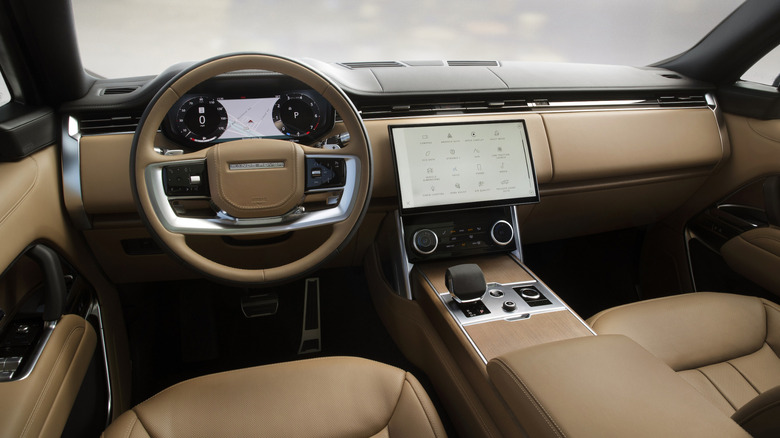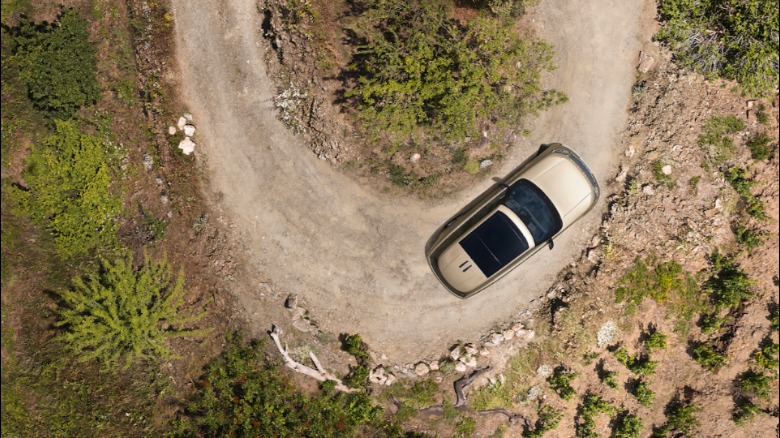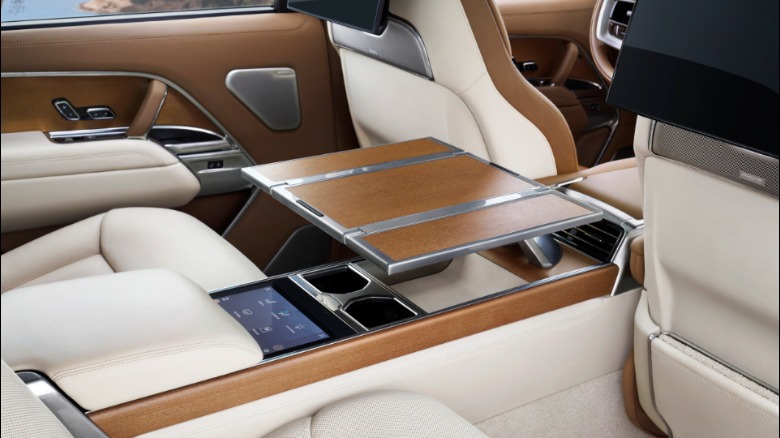The 5 Standout Features Of The New 2022 Range Rover
When you're driving an SUV that promises to "define modern luxury," picking your favorite features is unsurprisingly tricky. Such is the case with the new 2022 Range Rover. Now in its fifth generation, Land Rover's most luxurious model has huge aspirations to celebrate five decades of production — not to mention huge rivals aiming to eclipse this big SUV.
To rise to that challenge, Land Rover has pulled out all the stops. The 2022 Range Rover is more refined, more powerful, more environmentally friendly, and more lavish inside, as befits an SUV that starts at $105k but can easily spiral to three times that figure. After spending time behind the wheel it's far from easy to choose my five favorite features, but here's what stands out.
1. A modern approach to infotainment and updates
It's fair to say our expectations of the auto industry have been changed vastly by our experience with smartphones and tablets. Not only do we demand bigger touchscreens and more intuitive infotainment systems, but we expect car companies to deliver regular updates and introduce new features, too. It's a challenge the 2022 Range Rover promises to rise to.
As well as a new physical platform for the big SUV, there's also Land Rover's newest digital platform. Known as Electrical Vehicle Architecture (EVA 2.0), it interconnects more than 70 of the Range Rover's electronic modules, with support for over-the-air (OTA) updates over the lifespan of the SUV. It should mean that Land Rover can not only improve things like mapping data, but make improvements to other fundamental elements of the vehicle.
That's predominantly accessed by the largest central touchscreen of any Land Rover model, a 13.1-inch curved display that's subtly cantilevered off the dashboard. It's running Pivi Pro, the automaker's infotainment platform, with an admirably simplified UI that — in contrast to some of the Range Rover's rivals — doesn't feel overwhelming to navigate through.
You still get Apple CarPlay and Android Auto — both supporting wireless connections — and there's also Amazon Alexa, with voice control over the Range Rover's embedded data connection. SiriusXM with 360L is also available for the first time. That's all great, but I was particularly pleased to see that physical controls like volume, HVAC temperature, and fan speed knobs have been preserved. They're things you want to be able to reach out and quickly adjust, without digging through virtual menus.
Time will tell whether Land Rover's commitment to delivering OTA updates matches up to the Range Rover's capabilities of supporting them. Still, when you're spending six figures on a luxury SUV, the idea of it evolving and improving after it leaves the factory on day one is no longer a nice-to-have but an essential feature.
2. Active Noise Cancelling Headrests
Speakers in car headrests aren't a new feature, but Range Rover has gone a step further and used the technology to help isolate road and wind noise even more effectively. The new Range Rover's cabin is already a hushed place, with the new, stiffer platform helping keep it isolated from what's going on outside. In fact, the company claims, there's a 24% improvement in noise transmission from that architecture alone.
The SUV's engineers, though, weren't willing to stop at passive means to ensure this, however. The answer is a first for the auto industry: using the 20-watt headrest speakers in combination with the rest of the optional 1,600-watt Meridian Signature Sound System to create individual "quiet zones" for each passenger.
Four accelerometers are positioned outside the SUV, along with microphones. They track things like engine noise, sounds from the tires, and even the vibrations of the wheels, and then the active noise cancellation system calculates the inverse waves to smooth out those unwanted frequencies inside. It's like the ANC headphones many of us now can't imagine flying without, only without having to wear the headphones or earbuds themselves.
The result is a genuinely impressive degree of hush in the Range Rover cabin. The burble of the V8 can still be heard, when you're feeling playful with the accelerator, but generally this is one of the quietest SUVs I can remember driving. Of course, when the Range Rover BEV arrives in 2024, that could be even quieter still.
3. All-Wheel Steering
The 2022 Range Rover isn't a small SUV. In short wheelbase form it's a not-inconsiderable 16 feet 7 inches in length. Switch up to the long wheelbase version, and that extends to a whopping 17 feet 3 inches. That's two Smart Cars nose to nose.
If the thought of parking the vehicle, or maneuvering through tight city streets, brings you out in hives, fear not. For the 2022 model year, Land Rover has made all-wheel steering standard on the SUV. That makes a huge difference to how it drives.
As the name suggests, all-wheel steering means both the front and the rear wheels can turn as the Range Rover changes direction. The angle of that is far smaller at the back than it is at the front — up to seven degrees of steering angle, in fact — but it's how the SUV uses that which matters.
At lower speeds, such as when you're trying to creep around a narrow parking lot, the rear wheels steer in the opposite direction to those at the front. That shortens the turning circle to just 36 feet, or in fact the smallest of any Land Rover model. New Maneuvering Lights automatically bathe the SUV in a pool of light to improve visibility, too, with the 360-degree camera.
At faster speeds, such as when you're on the highway, the rear wheels turn in the same direction to the front wheels: that improves stability and comfort during things like lane changes. Range Rover isn't the first luxury automaker to adopt the technology, but that doesn't make it any less impressive — or useful — on the new SUV. The fact that it's a standard feature, where many rivals leave it as a paid option, is also worth noting.
4. Range Rover Signature Suite
With the option of a 4.4-liter twin-turbo V8 engine to play with, you'd be forgiven for assuming the best seat in the new Range Rover is the one that has the steering wheel. Spend the roughly $20,000 on the Range Rover Signature Suite upgrade, however, and that assumption will probably change.
That's not to say the standard five-seat configuration for the SUV is lacking, particularly when you fold down the center second-row seat to find a sizable touchscreen for comfort and media control. Even the seven-seat Range Rover is unexpectedly plush, with a surprising degree of legroom and shoulder space in the rearmost seats. They're comfortable enough for adults as well as kids, and have niceties like their own air vents, cupholders, and USB charging ports.
All that pales in comparison to the two second-row thrones that the Signature Suite includes. Effectively reclining loungers, each 24-way-adjustable seat has massage along with heating and cooling. It's like flying first class, though Land Rover's attention to detail is even higher.
The near-aniline leather is soft and supple, while the open pore wood and real brushed metal in the center console are elevated even further with craftsmanship like mosaic marquetry. Press a button on the touchscreen, meanwhile, and a pair of cupholders power into view: they're cam-driven for a smooth, quiet mechanism. Another button slides down the power-door to the refrigerator, scaled to fit a full-sized bottle and the two custom glasses.
If you really have to do some work, there's a Club Table which is also powered. It rises on a swan-neck of metal, unfolding into a spacious area for a laptop or — preferably — a picnic. When it comes time to settle into your food coma, you can move the front passenger seat forward remotely, summon a foot rest, and leave mundane things like driving to your chauffeur.
5. Looking beyond traditional luxury
Times are changing in the auto industry, and though the era of luxury vehicles shows no sign of stopping, just what is considered "truly luxurious" is evolving. The new Range Rover will begin to acknowledge that under the hood with the imminent arrival of the plug-in hybrid version, which combines a gas engine with battery-electric power. However it'll be the Range Rover BEV which truly embraces that green sentiment, though we're not expecting that variant to land until 2024.
In the meantime, though, Land Rover is also exploring what "luxury" means within the cabin. Although the expected options of leather, wood, and metal are all present and correct, they're joined now by a variety of less-common choices. That includes engineered textiles and Ultrafabrics.
For example, the SV Intrepid interior package combines Ultrafabrics in a duo-tone colorway with Kvadrat Remix wool-blend textile on the seat backs and headrests. It's a leather-free alternative to what you'd usually see in a high-end SUV, but without feeling like a low-grade compromise. Elsewhere, Land Rover's designers have used trim materials like real ceramic in some versions of the Range Rover, as an interesting substitution for metal.
There's still plenty of room to build on that, of course, and Land Rover is promising more by the time the Range Rover BEV arrives. Those feeling ambitious today, however, will be able to turn to the custom services of SV Bespoke, part of Land Rover's Special Vehicle Operations. The team there can whip up unique colors, trims, and more: assuming, that is, you have the budget for it.










